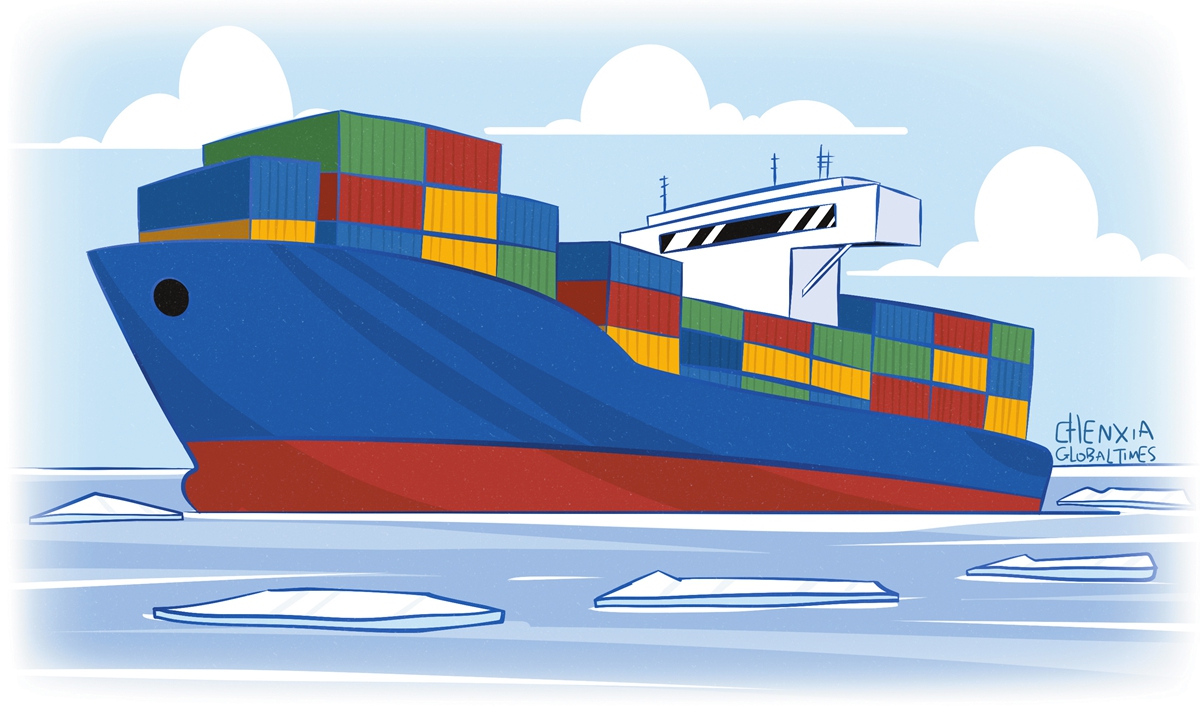China’s Arctic shipping endeavors embody a philosophy grounded in co-op, mutual benefit and resilience

Illustration: Chen Xia/GT
The recent departure of SeaLegend Line's Istanbul Bridge from Qingdao to Gdansk marks a new chapter in the evolution of global shipping.
SeaLegend Line is a Chinese shipping company founded in 2022. This time, it is launching its first direct container service between China and Northern Europe via the Northern Sea Route.
China's proactive efforts to develop the Arctic shipping lane are not just about crafting an alternative route to Europe. Instead, they embody a philosophy grounded in cooperation, mutual benefit and resilience - principles that are increasingly important in a world where trade can be vulnerable to the shocks of geopolitics and economic uncertainty.
Since its founding, SeaLegend Line has quickly risen to the forefront of international shipping innovation. The company's decision to send its first direct container service along this northern passage is remarkable not only for its pioneering spirit but also for how it reflects the broader objectives of China's shipping industry.
As global supply chains face mounting pressure from regional instability and competition for resources, it is clear that reliance on traditional maritime choke points - such as the Suez Canal and the Malacca Strait - carries its own risks.
Circumstances in recent years have demonstrated how easily a single incident or crisis can cascade through the world's interconnected supply routes, including the impact of the Russia-Ukraine conflict on the China-Europe Railway Express, from which China and Europe have mutually benefited for many years of regular operation.
In this context, the Arctic route emerges as a strategically significant solution.
China, with its advanced shipping technology and strong maritime industry foundation, is uniquely positioned to seize this opportunity.
The launch of the Istanbul Bridge voyage illustrates China's growing capabilities in building ice-class vessels, ensuring safe passage in challenging environments, and establishing robust logistical and communication networks that can support operations in some of the harshest environments on earth.
Beyond its technical prowess, China's approach to developing the Arctic route prioritizes inclusive cooperation over exclusive control.
The economic benefits of the Arctic route are clear. By enabling ships to bypass congested and sometimes unstable regions, the new lane can cut transit times between Chinese and European ports by up to two weeks. This translates directly into lower shipping costs, reduced fuel consumption, and greater agility for exporters and importers to respond to market demand.
Environmental considerations are central to the rationale for developing the Arctic route. Maritime shipping is a major contributor to greenhouse gas emissions, and the need to reduce the carbon footprint of international trade is urgent.
What distinguishes China's Arctic shipping endeavors is not competition for dominance, but a pursuit of development that can bring greater stability, resilience and fairness to global trade.
This cooperative outlook is especially significant in light of recent trends in international affairs, where tensions have sometimes led to calls for "decoupling" or technological exclusion.
By contrast, China's vision - embodied in the development of the Arctic route - promotes the idea that economic interdependence can be a source of strength, not vulnerability.
The new lane to Europe is not an exclusive highway, but an opportunity to build new connections, share knowledge and support development in regions that might otherwise be left at the periphery of global growth.
It is also important to note that greater route diversity supports the resilience of the entire global trading system. As the world becomes more interdependent, mutual reliance on multiple pathways offers a kind of insurance against future instability. Whether the cause is a geopolitical crisis, a natural disaster, or an unforeseen technical failure, the ability to reroute cargo quickly and efficiently is now an essential pillar of global economic security.
China is working hard to connect, not dismantle or divide, nor to control trade and connection systems.
Many hands will shape the Arctic's future, and China's early contributions, guided by principles of mutual respect and sustainable development, set an encouraging precedent. This new passage is not just a shortcut for cargo. Through openness, cooperation and a shared vision, it can deliver solutions to some of the world's most complex problems.
Photos
Related Stories
- Chancay-Shanghai shipping route boosts China-Peru trade
- Finnish shipping leader praises Chinese shipbuilding, calls for deeper collaboration
- World's largest solar-powered car carrier vessel completes maiden voyage
- China's first green methanol injection completed on diesel-fueled vessel
- Cargo throughput via Three Gorges Dam ship locks exceeds 2.2 bln tonnes over 22 yrs
Copyright © 2025 People's Daily Online. All Rights Reserved.









